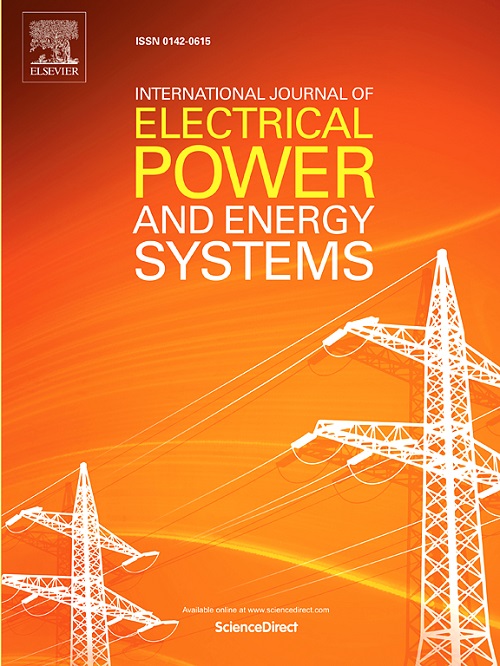基于混合整数线性规划的智能配电网电动汽车充电站优化布局
IF 5
2区 工程技术
Q1 ENGINEERING, ELECTRICAL & ELECTRONIC
International Journal of Electrical Power & Energy Systems
Pub Date : 2025-04-15
DOI:10.1016/j.ijepes.2025.110675
引用次数: 0
摘要
本文讨论了配电网中电动汽车充电站的优化配置问题。该方法是一个优化问题,其目标函数等于充电站建设成本和能源成本的最小化。不可避免地,在目标函数中也要考虑使电压与期望(参考)值的偏差最小。该问题的约束条件包括潮流方程、电动汽车和充电站的约束条件以及网络指标的约束条件。上述问题可以描述为混合整数非线性规划(MINLP)。然而,当网格的维度显著增加时,MINLP优化问题往往运行得非常慢,这就是为什么我们不太可能获得绝对最优解的原因。因此,提出了一个类似于主要问题的混合整数线性规划(MILP)公式。最后,在GAMS中建模了一个由69个总线组成的配电网络,以评估所提出的公式。在合理布局电动汽车充电站的方案中,上述充电站最初获得了较好的经济成本。以下通过对上述充电站的充电管理,使网络运行状况得到改善。无电动汽车时,最大电压降约为0.092p.u。能量损失达到2.08兆瓦。相比之下,电动汽车的电压降约为0.037p.u。能量损失降至约1.23兆瓦。本文章由计算机程序翻译,如有差异,请以英文原文为准。
Optimal charging station placement of electric vehicles in the smart distribution network based on the mixed integer linear programming
This article discusses the optimal placement of electric vehicle charging stations in the distribution network. The proposed approach is an optimization problem with the objective function equal to minimizing the cost of building charging stations and energy costs. Inevitably, minimizing the voltage deviation from the desired (reference) value is also considered in the objective function. The constraints of this problem include the equations of power flow, the restrictions governing electric vehicles and charging stations, and the limitations of network indicators. The mentioned problem can be described as mixed integer nonlinear programming (MINLP). Nevertheless, the MINLP optimization problem tends to run very slowly when the dimension of the grid increases significantly, and that’s why it is unlikely that we obtain an absolute optimal solution. Consequently, a mixed integer linear programming (MILP) formulation that resembles the main problem is developed. Ultimately, a distribution network consisting of 69 buses is modeled in GAMS to evaluate the proposed formulation. In the proposed plan with the appropriate placement of electric vehicle charging stations, initially a favorable economic cost is obtained for the aforementioned stations. In the following, charging management at the aforementioned stations has caused the network operation status to improve. When EVs are absent, the maximum voltage drop is approximately 0.092p.u. and energy losses reach 2.08 MW. In contrast, with EVs present the voltage drop falls to about 0.037p.u. and energy losses drop to roughly 1.23 MW.
求助全文
通过发布文献求助,成功后即可免费获取论文全文。
去求助
来源期刊
CiteScore
12.10
自引率
17.30%
发文量
1022
审稿时长
51 days
期刊介绍:
The journal covers theoretical developments in electrical power and energy systems and their applications. The coverage embraces: generation and network planning; reliability; long and short term operation; expert systems; neural networks; object oriented systems; system control centres; database and information systems; stock and parameter estimation; system security and adequacy; network theory, modelling and computation; small and large system dynamics; dynamic model identification; on-line control including load and switching control; protection; distribution systems; energy economics; impact of non-conventional systems; and man-machine interfaces.
As well as original research papers, the journal publishes short contributions, book reviews and conference reports. All papers are peer-reviewed by at least two referees.

 求助内容:
求助内容: 应助结果提醒方式:
应助结果提醒方式:


